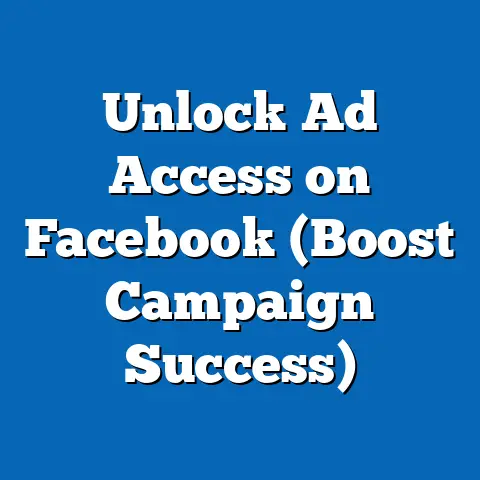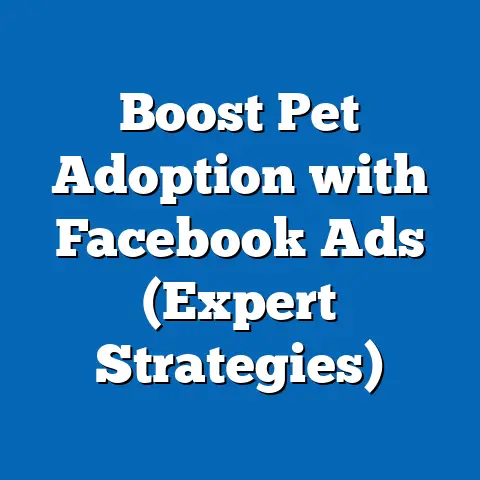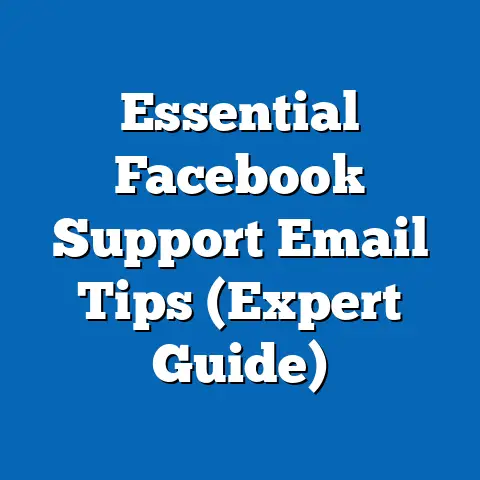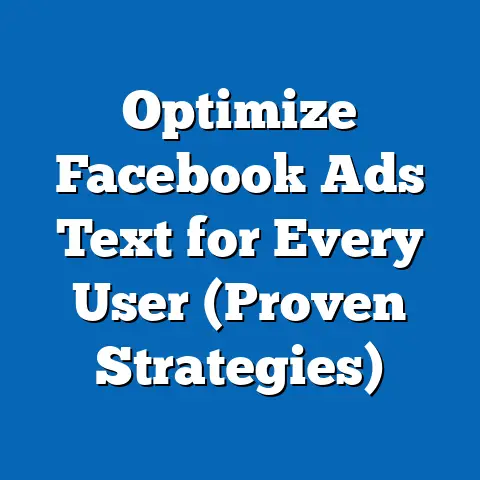Boost Google Ads to Facebook Page (Expert Strategies)
Did you know that businesses that integrate their Google Ads and Facebook marketing strategies can see up to a 30% increase in conversion rates? What if the key to unlocking your Facebook page’s potential lies in your Google Ads campaign? In an era where digital marketing is more intricate than ever, understanding how to effectively funnel your Google Ads traffic to your Facebook page may just be the game-changer you’ve been seeking. I’ve seen firsthand how a coordinated approach can transform a stagnant Facebook presence into a thriving community. This article will explore expert strategies to help you leverage your Google Ads for maximum impact on your Facebook presence, sharing insights I’ve gleaned from years of navigating the ever-evolving digital landscape.
Understanding the Synergy Between Google Ads and Facebook
Google Ads and Facebook advertising, while both powerful tools, operate on fundamentally different principles. Google Ads primarily targets users based on their search intent. When someone types a specific query into Google, they’re actively looking for something – a product, a service, or information. Your Google Ads, when strategically placed, appear precisely when that need arises, offering a solution at the moment of peak relevance.
Facebook, on the other hand, thrives on user behavior and interests. It’s a platform where people connect with friends, discover new content, and engage with brands that resonate with their values and lifestyle. Facebook advertising leverages this rich tapestry of user data to target ads based on demographics, interests, behaviors, and even connections.
The magic happens when you combine these two platforms. Imagine someone searching for “best running shoes” on Google, clicking on your ad, and then finding their way to your Facebook page. Now, they’re not just a visitor; they’re a potential follower, a future customer, and a member of your brand community.
The benefits of this integration are numerous:
- Increased Reach: Tap into both search-driven traffic and passively engaged audiences.
- Enhanced Audience Targeting: Refine your targeting on both platforms based on insights gained from the other.
- Improved Brand Awareness: Reinforce your brand message across multiple touchpoints.
- Higher Conversion Rates: Nurture leads through a carefully crafted customer journey.
I remember working with a local bakery that was struggling to gain traction on Facebook. Their Google Ads were generating decent website traffic, but they weren’t seeing any engagement on their Facebook page. By strategically linking their Google Ads to their Facebook page and creating compelling content that reflected their Google Ads messaging, they saw a 40% increase in Facebook followers and a significant boost in online orders. This is a testament to the power of a unified approach.
Takeaway: Google Ads captures intent, while Facebook nurtures relationships. Combining them creates a powerful marketing ecosystem.
Setting Up Your Google Ads for Facebook Promotion
Optimizing your Google Ads to drive traffic to your Facebook page requires a deliberate strategy. It’s not just about slapping a link in your ad; it’s about crafting a compelling narrative that draws users into your brand’s world.
Here’s a step-by-step approach:
- Keyword Selection: Choose keywords that are relevant to your Facebook page’s content and target audience. Think about the search terms that your ideal follower would use. For example, if your Facebook page focuses on sustainable living, target keywords like “eco-friendly products,” “sustainable lifestyle tips,” and “zero waste living.”
- Compelling Ad Copy: Your ad copy is your first impression. It needs to be engaging, informative, and, most importantly, relevant to the search query. Clearly state the value proposition of visiting your Facebook page. For example: “Discover sustainable living tips and eco-friendly products on our Facebook page! Join our community today.”
- Ad Extensions: Utilize ad extensions to provide additional information and encourage clicks. Sitelink extensions can direct users to specific sections of your Facebook page, such as your “About” section or your latest posts. Callout extensions can highlight key benefits of following your page, such as exclusive discounts or behind-the-scenes content.
- Strong Call-to-Action: Your call-to-action (CTA) should be clear, concise, and action-oriented. Use phrases like “Visit our Facebook page,” “Join our community,” or “Follow us for exclusive content.” Make sure your CTA is visually prominent and easy to click.
I’ve found that ads with a clear and compelling CTA perform significantly better. For instance, an ad that simply says “Check out our Facebook page” is less effective than one that says “Join our Facebook community for daily inspiration and exclusive discounts!” The latter provides a clear benefit and encourages immediate action.
Here are a few examples of high-performing Google Ads that have successfully driven traffic to Facebook:
-
Example 1: Fitness Brand
- Headline: Get Fit with Our Facebook Community!
- Description: Join our Facebook group for daily workout tips, healthy recipes, and motivational support.
- CTA: Follow us on Facebook!
-
Example 2: Local Restaurant
-
Headline: Exclusive Deals on Our Facebook Page!
- Description: Like our Facebook page for weekly discounts, menu updates, and behind-the-scenes glimpses of our kitchen.
- CTA: Visit our Facebook page!
-
Example 3: Tech Startup
-
Headline: Stay Updated with Tech Trends on Facebook!
- Description: Follow our Facebook page for the latest tech news, product reviews, and industry insights.
- CTA: Join the conversation on Facebook!
Example 1: Fitness Brand
- Headline: Get Fit with Our Facebook Community!
- Description: Join our Facebook group for daily workout tips, healthy recipes, and motivational support.
- CTA: Follow us on Facebook!
-
Example 2: Local Restaurant
-
Headline: Exclusive Deals on Our Facebook Page!
- Description: Like our Facebook page for weekly discounts, menu updates, and behind-the-scenes glimpses of our kitchen.
- CTA: Visit our Facebook page!
-
Example 3: Tech Startup
-
Headline: Stay Updated with Tech Trends on Facebook!
- Description: Follow our Facebook page for the latest tech news, product reviews, and industry insights.
- CTA: Join the conversation on Facebook!
Example 2: Local Restaurant
Headline: Exclusive Deals on Our Facebook Page!
Example 3: Tech Startup
Headline: Stay Updated with Tech Trends on Facebook!
Takeaway: Craft Google Ads that explicitly promote your Facebook page, highlighting the value of joining your community.
Crafting Compelling Landing Pages
While directly linking your Google Ads to your Facebook page can be effective, creating a dedicated landing page offers even greater control over the user experience and can significantly improve conversion rates. A landing page acts as a bridge, seamlessly transitioning users from Google Ads to your Facebook page while reinforcing your brand message and highlighting the benefits of joining your community.
Here’s what makes a compelling landing page:
- Design Elements: Your landing page should be visually appealing and consistent with your brand’s aesthetic. Use high-quality images, videos, and graphics to capture attention and convey your brand’s personality. Ensure the page is mobile-friendly and loads quickly.
- Messaging Consistency: The messaging on your landing page should align with the messaging in your Google Ads. Reinforce the value proposition of visiting your Facebook page and highlight the benefits of joining your community.
- User Experience: Make it easy for users to navigate your landing page and find the information they’re looking for. Use clear headings, concise paragraphs, and bullet points to present information in an easily digestible format.
- Social Proof: Include social proof, such as testimonials, reviews, and engagement metrics (e.g., number of followers, likes, shares), to build trust and credibility. Showcase positive feedback from satisfied customers or highlight the active and engaged nature of your Facebook community.
- Clear Call-to-Action: Your CTA should be prominent and compelling, encouraging users to visit your Facebook page. Use phrases like “Join our Facebook community,” “Follow us for exclusive content,” or “Discover more on Facebook.”
I’ve seen landing pages that incorporate a live feed of recent posts from the Facebook page perform particularly well. This gives visitors a real-time glimpse of the content they can expect to see if they follow your page.
Remember, the goal is to create a seamless and engaging experience that makes users want to join your Facebook community.
Takeaway: A well-designed landing page acts as a bridge, guiding users from Google Ads to your Facebook page while reinforcing your brand message and building trust.
Utilizing Retargeting Strategies
Retargeting is a powerful technique that allows you to re-engage users who have previously interacted with your Google Ads or visited your website. By setting up retargeting campaigns on both Google Ads and Facebook, you can guide these users back to your Facebook page and encourage them to join your community.
Here’s how to implement a successful retargeting strategy:
- Google Ads Retargeting: Create a retargeting list in Google Ads that includes users who have clicked on your ads and visited your website. Target these users with ads that specifically promote your Facebook page, highlighting the benefits of joining your community.
- Facebook Retargeting: Create custom audiences in Facebook Ads based on users who have visited your website, interacted with your Google Ads, or engaged with your Facebook page. Target these users with ads that are tailored to their specific interests and behaviors. For example, you could target users who visited your website but didn’t join your Facebook page with ads that showcase the exclusive content and benefits they’re missing out on.
- Audience Segmentation: Segment your audience based on their level of engagement. Target users who are highly engaged with your brand (e.g., frequent website visitors, active Facebook followers) with ads that encourage them to become brand advocates. Target users who are less engaged with ads that reintroduce your brand and highlight the value of joining your Facebook community.
I’ve found that retargeting ads with a personalized message perform significantly better. For example, an ad that says “We noticed you visited our website! Join our Facebook community for exclusive discounts and behind-the-scenes content” is more likely to grab attention than a generic ad that simply promotes your Facebook page.
Takeaway: Retargeting allows you to re-engage users who have previously shown interest in your brand, guiding them back to your Facebook page and encouraging them to join your community.
Measuring Success and Analyzing Data
Measuring the success of your Google Ads to Facebook page strategy is crucial for optimizing your campaigns and maximizing your ROI. Tracking the right key performance indicators (KPIs) and analyzing the data will provide valuable insights into user behavior and engagement levels.
Here are some key KPIs to track:
- Facebook Page Followers: Monitor the growth of your Facebook page followers over time. This is a direct indicator of the effectiveness of your Google Ads in driving traffic to your page.
- Website Traffic from Google Ads: Track the amount of traffic your Facebook page receives from Google Ads. Use Google Analytics to segment traffic by source and medium to identify the specific campaigns that are driving the most traffic.
- Engagement Metrics: Monitor engagement metrics on your Facebook page, such as likes, comments, shares, and reach. This will provide insights into the quality of the traffic you’re driving from Google Ads. Are users engaging with your content? Are they finding value in your Facebook community?
- Conversion Rates: Track conversion rates on your Facebook page, such as sign-ups, leads, and sales. This will help you determine the ROI of your Google Ads to Facebook page strategy.
- Cost Per Acquisition (CPA): Calculate the CPA for each Google Ads campaign to determine the cost of acquiring a new Facebook follower. This will help you optimize your ad spend and focus on the campaigns that are delivering the best results.
Use tools like Google Analytics and Facebook Insights to analyze user behavior and engagement levels. Google Analytics provides detailed data on website traffic, including source, medium, and landing page. Facebook Insights provides data on Facebook page engagement, including reach, likes, comments, shares, and demographics.
By analyzing this data, you can identify trends, patterns, and areas for improvement. For example, you might discover that certain keywords in your Google Ads are driving more traffic to your Facebook page than others. Or you might find that certain types of content on your Facebook page are generating more engagement than others.
Takeaway: Tracking KPIs and analyzing data is essential for optimizing your Google Ads to Facebook page strategy and maximizing your ROI.
Advanced Techniques and Best Practices
Once you’ve mastered the basics, you can delve into more advanced techniques to further optimize your Google Ads to Facebook page strategy.
Here are a few expert-level strategies:
- A/B Testing: A/B test different ad creatives, landing pages, and targeting options to identify the most effective combinations. Test different headlines, descriptions, images, and CTAs to see what resonates best with your target audience.
- Ad Spend Optimization: Continuously monitor your ad spend and adjust your bids based on performance. Focus your budget on the campaigns that are delivering the best results and reduce spend on the campaigns that are underperforming.
- Ad Scheduling: Schedule your ads to run during peak engagement times on Facebook. Use Facebook Insights to identify the times when your audience is most active and schedule your ads accordingly.
- Leveraging Facebook’s Advertising Features: Utilize Facebook’s advanced advertising features, such as lookalike audiences and custom audiences, to reach new users who are similar to your existing Facebook followers.
- Stay Updated: The digital marketing landscape is constantly evolving. Stay updated with the latest trends in Google Ads and Facebook advertising and adapt your strategies accordingly.
I’ve found that staying agile and adapting to changes in the algorithm is crucial for long-term success. What worked last year might not work this year, so it’s important to continuously test, iterate, and refine your strategies.
Takeaway: Advanced techniques like A/B testing, ad spend optimization, and leveraging Facebook’s advertising features can help you further optimize your Google Ads to Facebook page strategy and maximize your ROI.
Conclusion
Integrating your Google Ads with Facebook marketing strategies is a powerful way to enhance visibility, engagement, and ultimately, your bottom line. By understanding the unique strengths of each platform, crafting compelling ad copy, creating dedicated landing pages, utilizing retargeting strategies, and continuously measuring and analyzing your results, you can unlock the full potential of your Facebook page.
Remember, the key is to create a seamless and engaging experience that makes users want to join your Facebook community.
Now, it’s time to put these expert strategies into action. Start implementing these techniques today and witness the transformation in your Facebook page performance. Are you ready to take your Facebook presence to the next level? Go forth and conquer!




